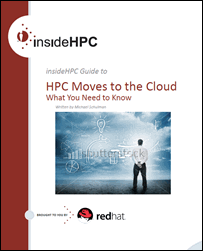This is the first entry in an insideHPC series that explores the HPC transition to the cloud, and what your business needs to know about this evolution. Compiled in a complete Guide, we cover cloud computing, industry examples, IaaS components, OpenStack fundamentals, and more.
While some domains that rely on computing systems are satisfied with the performance gains that are continuously delivered from processor manufacturers, others require performance that can only be attained through massive parallelism. High-performance computing is for those that need the highest performance in order to solve many of today’s most difficult scientific challenges.
By aggregating hundreds to thousands of computing elements with large amounts of memory and very high-speed networking, organizations can solve problems that were never attempted before. Simulations can have more resolution than ever before, and can be run at a lower overall cost as well. Creating a productive system that includes CPUs, accelerators, memory, storage and networking is no simple task, especially one that performs at high scale. While the hardware components can be obtained from multiple vendors, the software—the glue that binds the components together—must be modern, extensible, high performance and flexible.
[clickToTweet tweet=”HPC is for those that need the highest performance in order to solve today’s most difficult scientific challenges.” quote=”HPC is for those that need the highest performance in order to solve today’s most difficult scientific challenges.”]
System Features for HPC Workloads
Although the definition of an HPC workload may vary, there are certain characteristics that many domains require in order to reach a solution in a timely and expected manner.
- Fast CPUs − The ability to arrive at a solution is greatly dependent on the latest CPU designs from leading manufacturers
- Accelerators − Many applications have been modified to take advantage of the latest single instruction, multiple data, or SIMD, and vectorization that accelerators have made available in standard designs.
- Memory − In general, the more memory available to the application, the better. Data that is stored in memory can be accessed significantly faster by the CPU than data stored on hard disk drivers.
- Storage − The amount of data that is used for many HPC applications is significant. Petabytes of data may need to be accessed to obtain a solution. The performance of the storage subsystem is crucial for an HPC system.
- Network − As more and more applications have been modified or developed to use the processing power of many servers, the bandwidth and latency of the network are critically important.
While the hardware components can be obtained from multiple vendors, the software—the glue that binds the components together—must be modern, extensible, high-performance and flexible.
Industry Examples That Require HPC Solutions
GENOMICS
Sequencing a genome requires a significant amount of computing power to take the hundreds of gigabytes of data and determine the alignments. While not floating point-intensive, gene sequencing relies heavily on storage networking and CPU performance.
MANUFACTURING
All manufacturing industries are determined to reduce costs and create more efficient products. By simulating how solid objects react to loads to how an object behaves with fluid flowing internally or externally, computer-aided engineering applications rely on the fastest CPUs, accelerators and networking. While the output may be significant for a given application, the speed of storage may not be the limiting performance factor.
COMPUTATIONAL CHEMISTRY
Chemical interactions can be modelled that assist in solving a variety of chemistry and molecular problems. Using HPC, these interactions can be mathematically modelled in order to determine the structures and the properties of molecules and solids. These types of simulations rely on very fast access to chemical databases as well as the latest CPU performance.
FINANCIAL MODELING
Milliseconds matter when determining financial trades, and although not a traditional HPC (long computational time) domain, so performance is important. Determining whether to buy or sell based on many points of data just milliseconds before another system makes the same determination can result in significant benefit.
ENERGY EXPLORATION
Determining whether underground structures contain energy reserves and the best methods to extract these fuels can save millions of dollars. A dry well uses up resources and costs a lot of money. HPC technologies are used heavily in the energy exploration area and rely on fast CPUs, accelerators, storage and networking.
Determining whether underground structures contain energy reserves and the best methods to extract these fuels can save millions of dollars.
SCIENCE AND RESEARCH
One of the most demanding domains for HPC applications are research institutions, universities and national research labs. The organizations run extremely complex simulations that may use hundreds of thousands of processing cores and run for weeks at a time. The range of simulations is diverse, and most of these applications need the power and efficiency of a well- tuned HPC system. (Learn more about the Red Hat IaaS Suite for Science and Research Technology.)
Over the next few weeks this series on the HPC transition to the cloud will cover the following additional topics:
- Cloud Computing
- IaaS Componants
- OpenStack Fundamentals
- Future Directions
You can also download the complete report, “insideHPC Research Report on HPC Moves to the Cloud – What You Need to Know,” courtesy of Red Hat.




